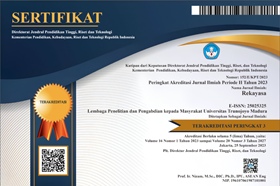Analysis of Slip Plane Using Geoelectric Data in Pancor Dao Central Lombok
Abstract
Landslide are one of the disasters that occur in sloping areas. It occurs very often when the intensity of rainfall is high. Apart from that, it occurs in an area known as a slip area. The slip area is characterized by contrasting rock resistivity values. This research aims to determine the resistivity value of the soil indicated as a sliding area using the geoelectric method with a dipole-dipole configuration. A dipole-dipole configuration is used to get a deeper penetration value compared to other configurations. Field data collection was carried out on 3 tracks with a research area of around 1,000 m2. Based on the results of data processing using 2D Res2divn inversion, the soil resistivity value is obtained which is indicated as a slip plane. The soil resistivity value indicated as a slip plane on 3 line, namely resistivity value on line 1 of 973 Ωm - 2067 Ωm, line 2 of 1202 Ωm - 3167 Ωm, line 3 of 618 Ωm – 1391 Ωm which is classified as a type of silt clay soil. the results show that the depth of slip plane on the third line is deeper than the first line and second line. From the soil resistivity values, it represents the slip plane. And the depth of slip plane on 3 line, namely at a depth of 8.53 m - 12.7 m for the first line, 5.13 - 16.3 m for the second line, and 1.71 - 17 m for the third line. And categorized as shallow to deep slip plane types.
Keywords
Full Text:
PDFReferences
Agustina, E. (2014). Identifikasi Bidang Gelincir Zona Rawan Longsor dengan Metode Geolistrik Resistivitas Konfigurasi Dipole-Dipole Di Payung Kota Batu. In Jurnal Fisika Universitas Negeri Malang. Universitas Negeri Malang.
Aliyatarrafiah, & Widada, S. (2014). Identifikasi Bidang Gelincir Dengan Metode Tahanan Jenis Konfigurasi Dipole-Dipole Daerah Bambankerep Ngaliyan Semarang. Youngster Physics Journal, 3(4), 291–298.
Arsyad, U., Barkey, R. A., Wahyuni, W., & Matandung, K. K. (2018). Karakteristik Tanah Longsor di Daerah Aliran Sungai Tangka. Jurnal Hutan Dan Masyarakat, 203. https://doi.org/10.24259/jhm.v0i0.3978
Bell, R., Kruse, J.-E., Garcia, A., Glade, T., & Hördt, A. (2006). Subsurface investigations of landslides using geophysical methods : geoelectrical applications in the Swabian Alb (Germany). Geographica Helvetica, 61(3), 201–208. https://doi.org/10.5194/gh-61-201-2006
Dzakiya, N., Laksmana, R. B., & Hidayah, R. A. (2023). Identifying Probable Slip Surface in Wanurejo, Borobudur District, By Subsurface Analysis Utilizing the Dipole-Dipole Configuration of Resistivity Method. Journal of Applied Geospatial Information, 7(1), 739–746. https://doi.org/10.30871/jagi.v7i1.5055
Ewusi, A. (2006). Groundwater Exploration and Management using Geophysics : Northern Region of Ghana. November 2006, 171.
Fadillah, R., Tjahjono, B., & Dwiyanti, F. G. (2024). Landslide Hazard Analysis Based on Geographic Information Systems in Sumedang Regency. Jurnal Penelitian Pendidikan IPA, 10(SpecialIssue), 147–158. https://doi.org/10.29303/jppipa.v10ispecialissue.8354
Green, R. (1993). Applied geophysics. Journal of Applied Geophysics, 30(4), 322–323. https://doi.org/10.1016/0926-9851(93)90043-x
Hadmoko, D. S., Lavigne, F., & Samodra, G. (2017). Application of a semiquantitative and GIS-based statistical model to landslide susceptibility zonation in Kayangan Catchment, Java, Indonesia. Natural Hazards, 87(1), 437–468. https://doi.org/10.1007/s11069-017-2772-z
Hajar Saleng, R., Arbie, A., & Gede Eka, D. (2024). Simulasi Model Material Tanah Pada Bidang Gelincir Longsor Dengan Variasi Sudut Kemiringan (Studi Kasus Material Tanah di Daerah Kabupaten Gorontalo Utara). Jurnal Teori Dan Aplikasi Fisika, 12(01), 29–38. https://doi.org/10.23960/jtaf.v12i1.3207
Hendri, H., Faryuni, I. D., & Zulfian, Z. (2020). Identifikasi Bidang Gelincir dan Tipe Tanah Longsor di Daerah Rawan Longsor Desa Bantai Menggunakan Metode Geolistrik. Prisma Fisika, 7(3), 167. https://doi.org/10.26418/pf.v7i3.36329
Hidayah, R. A., & Dzakiya, N. (2018). Analysis Geological and Geophysical Data for Prediction Landslide Hazard Zone with Weight of Evidence Method in Pacitan District East Java. Journal of Applied Geospatial Information, 2(1), 117–123. https://doi.org/10.30871/jagi.v2i1.830
Karimah, K., Susilo, A., Suryo, E. A., Rofiq, A., & Hasan, M. F. R. (2022). 3D Modelling of Geoelectrical Resistivity Data to Determine the Direction of Landslides in Kastoba Lake, Bawean Island, Indonesia. Jurnal Penelitian Pendidikan IPA, 8(3), 1495–1502. https://doi.org/10.29303/jppipa.v8i3.1714
Khan, G. D., Waheedullah, & Bhatti, A. S. (2013). Groundwater Investigation by Using Resistivity Survey in Peshawar, pakistan. Journal of Research Development and Management, 2, 9–20.
Mahmudi, A. K. (2018). Investigasi Keberadaan dan Arah dari Pipa Bawah Tanah dengan Metode Kelistrikan. Rekayasa, 1, 1. https://doi.org/Agus Mahmudi, Kuspijani Kuspijani
Nordiana, M. M., Azwin, I. N., Nawawi, M. N. M., & Khalil, A. E. (2018). Slope failures evaluation and landslides investigation using 2-D resistivity method. NRIAG Journal of Astronomy and Geophysics, 7(1), 84–89. https://doi.org/10.1016/j.nrjag.2017.12.003
Perrone, A., Vassallo, R., Lapenna, V., & Di Maio, C. (2008). Pore water pressures and slope stability: A joint geophysical and geotechnical analysis. Journal of Geophysics and Engineering, 5(3), 323–337. https://doi.org/10.1088/1742-2132/5/3/008
Peruccacci, S., Brunetti, M. T., Gariano, S. L., Melillo, M., Rossi, M., & Guzzetti, F. (2017). Rainfall thresholds for possible landslide occurrence in Italy. Geomorphology, 290, 39–57. https://doi.org/10.1016/j.geomorph.2017.03.031
Prastowo, R., Helmi, H., Trianda, O., & Umam, R. (2021). Identification of Slip Surfaces Using the Geoelectric Imaging Method in the Kalirejo Area, Kokap District, Yogyakarta, Indonesia. JIPF (Jurnal Ilmu Pendidikan Fisika), 6(3), 234. https://doi.org/10.26737/jipf.v6i3.2072
Pratiwi, E. S., Sartohadi, J., & Wahyudi. (2019). Geoelectrical Prediction for Sliding Plane Layers of Rotational Landslide at the Volcanic Transitional Landscapes in Indonesia. IOP Conference Series: Earth and Environmental Science, 286(1), 0–9. https://doi.org/10.1088/1755-1315/286/1/012028
Rhesdeantia, Y., Darsono, T., & Khumaedi, K. (2017). Geo-Electric Resistivity Method of Dipole-Dipole Configuration For Cavities Model 2D in Karst Area of Temurejo Village Gubug Sub-district Central Java District. Journal of Physics: Theories and Applications, 1(2), 167. https://doi.org/10.20961/jphystheor-appl.v1i2.19318
Šilhán, K., Tichavský, R., Fabiánová, A., Chalupa, V., Chalupová, O., Škarpich, V., & Tolasz, R. (2019). Understanding complex slope deformation through tree-ring analyses. Science of the Total Environment, 665, 1083–1094. https://doi.org/10.1016/j.scitotenv.2019.02.195
Sismanto, & Nasharuddin. (2018). Landslide potential mapping in penggung purwosari village, district girimulyo, kulonprogo, yogyakarta province, Indonesia using dipole-dipole resistivity method. International Journal of Civil Engineering and Technology, 9(6), 1141–1150.
Sugito, Irayani, Z., & Jari, I. P. (2010). Investigasi Bidang Gelincir Tanah Longsor Menggunakan Metode Geolistrik Tahanan Jenis di Desa Kebarongan Kec. Kemranjen Kab. Banyumas. Berkala Fisika, 13(2), 49–54.
Summa, V., Margiotta, S., Colaiacovo, R., & Giannossi, M. L. (2015). The influence of the grain-size, mineralogical and geochemical composition on the Verdesca landslide. Natural Hazards and Earth System Sciences, 15(1), 135–146. https://doi.org/10.5194/nhess-15-135-2015
Suprianto, A. (2018). Pencitraan Rembesan Limbah Menggunakan Metode Geolistrik Resistivity Konf igurasi Schlumberger 2-dimensi. Rekayasa, 1(1), 7. https://doi.org/https://doi.org/10.21107/rekayasa.v1i1.2167
Susilo, A., Suryo, E. A., Fitriah, F., Sutasoma, M., & Bahtiar. (2018). Preliminary study of landslide in Sri Mulyo, Malang, Indonesia using resistivity method and drilling core data. International Journal of GEOMATE, 15(48), 161–168. https://doi.org/10.21660/2018.48.59471
Ulfah, S., Marzuki, M., & Susilo, A. (2021). Analysis Vulnerability Disaster of Landslide in Lantan Village Using Geoelectric Data and Sentinel Image. Jurnal Penelitian Pendidikan IPA, 7(4), 794–801. https://doi.org/10.29303/jppipa.v7i4.915
Wardoyo, T. M. A. (2018). Investigasi RembesanfKebocoran Dinding Suatu KanaVSungai yang Terkontaminasi dengan Metode Resistivitas. Rekayasa, 1(1), 7. https://doi.org/https://doi.org/10.21107/rekayasa.v1i1.2163
Yatini, Y., & Suyanto, I. (2018). Identification of slip surface based on geoelectrical dipole-dipole in the landslides hazardous area of Gedangsari District, Gunungkidul Regency, Province of Daerah Istimewa Yogyakarta, Indonesia. IOP Conference Series: Earth and Environmental Science, 212(1). https://doi.org/10.1088/1755-1315/212/1/012013
Yilmaz, S. (2011). A case study of the application of electrical resistivity imaging for investigation of a landslide along highway. International Journal of Physical Sciences, 6(24), 5843–5849. https://doi.org/10.5897/IJPS11.564
Zakaria, M. F., & Maisarah, S. M. (2020). Identifikasi Bidang Gelincir Pada Daerah Rawan Longsor Desa Srimartani, Yogyakarta. JGE (Jurnal Geofisika Eksplorasi), 5(3), 214–222. https://doi.org/10.23960/jge.v5i3.36
DOI
https://doi.org/10.21107/rekayasa.v18i1.26538Metrics
Refbacks
- There are currently no refbacks.
Copyright (c) 2025 Syarifatul Ulfah, Adi Susilo

This work is licensed under a Creative Commons Attribution-ShareAlike 4.0 International License.
























